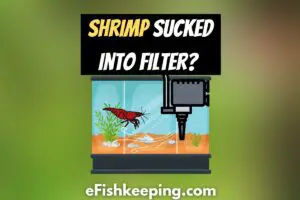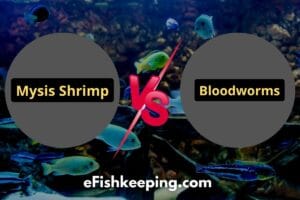Let’s face it, doing frequent water changes to prevent ammonia buildup is one of the primary headaches of fish tank maintenance (especially if you have a tight schedule).
And as you’re well aware, fish waste is a major source of ammonia that causes problems in the aquarium.
What if there was a tank species that could eat the poop and make your tank maintenance job easy!
Do Shrimps Eat Fish Poop?
| What Shrimps Eat: | What Shrimps Don’t Eat: |
| Leftover Foods | Fish Poop |
| Algae | Snail Poop |
| Shrimp Pellets |
In short, shrimp don’t eat fish poop.
Some fish tank owners often report that they have seen their ghost shrimp playing with fish poop and even munching on them. So if that’s what happened with you, it’s natural to wonder if your shrimps will be OK from it or not.
And the short answer is that it is their normal behavior, and you don’t need to worry much about it. The moment the shrimp realizes it’s eating poop, the shrimp will discard it soon.
Here’s the thing:
Excreta of other fish species aren’t a common food source for fish and invertebrates. Shrimp sometimes pick up particles of excrement to examine them for possible edible qualities, but they never actually eat them.
If you are wondering if shrimps like the ghost shrimp can help you reduce fish waste and poop, the answer is no.
At the most, you can think of adding more plants to your tank and consider the fish poop (which is an organic waste) to be used as a natural fertilizer by the plants. But still, not all the fish poop will be absorbed in that way as organic waste.
Look:
The ammonia produced by fish waste will reach toxic levels, threatening the aquarium’s environment if no action is taken to reduce it.
The nitrogen cycle in the aquarium helps prevent this from happening. Additionally, plants help manage the ammonia levels in the tank.
But if the concentrations of nitrates and ammonia get too high, it will be challenging to keep the water parameters in check.
So to avoid an overabundance of waste from building up within the tank, it is essential that you regularly clean it.
Are There Any Tank Species That Eat Fish Poop?
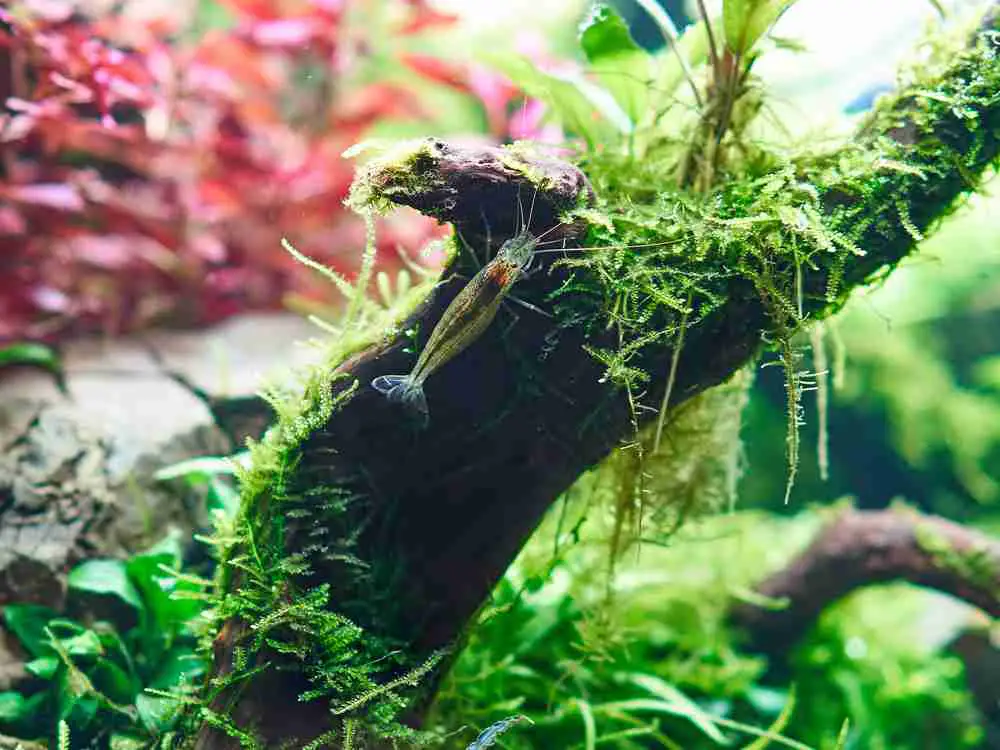
Unfortunately, there are no tank species that can help you get rid of fish poop, including shrimps.
I know, you might have heard that fish like pleco can eat fish poop and clean the water. But that’s actually one of the biggest myths in the aquarium hobby.
No fish, no snails, and no shrimp can help you to clear the fish poop from the aquarium.
Sure, these cleaner crew members of the tank can help you keep algae growth at bay. And they can also clean dead plant matter and other organic waste from the tank. But they don’t have any special interest in fish poop.
Why?
Well, it’s simply because fish poop is not a nutritive source for them. Also, they don’t find it to be a tasty meal.
Occasionally, you may have seen some of your tank species gulping down the poop of other fish. But most of the time, it happens by mistake. As soon as they realize the thing, it doesn’t take them long to spit it out of their mouth.
What’s The Solution Then – How To Get Rid Of Fish Poop?
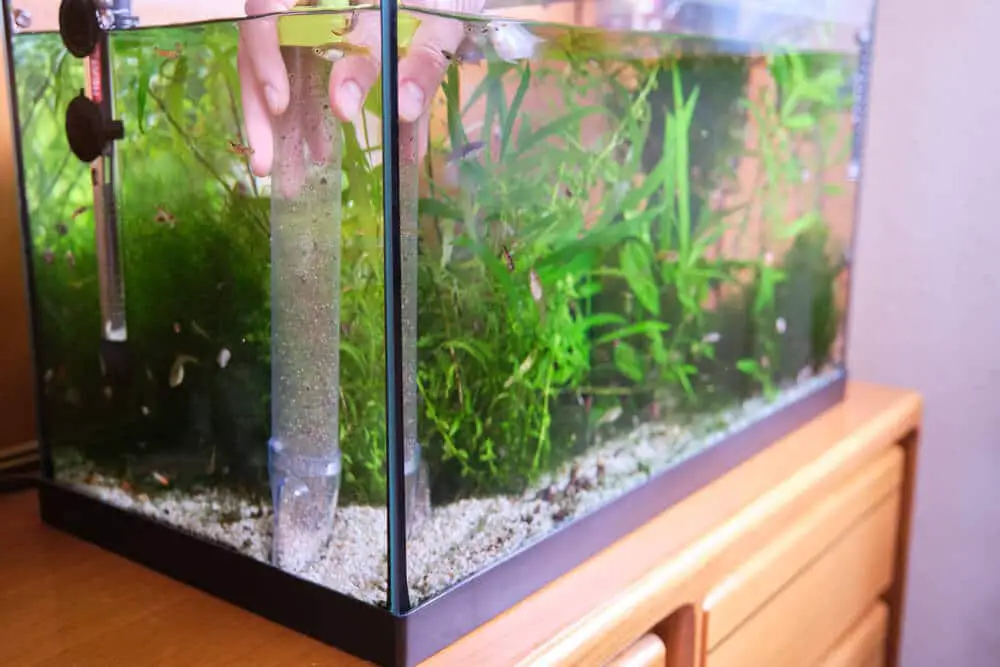
#1. Use Gravel Vac – Easiest And Smartest Way!
Using a gravel vacuum will be the quickest and most convenient method to maintain your gravel and clean fish poop. As the fish poop, it sinks below and gets collected between the crevices and gaps of gravel.
Over time, all the fish waste can build up in the gravel. However, with a gravel vacuum, you can clean all the dirt quite easily.
For cleaning up leftovers, and fish excrement, the gravel vacuum uses a siphon effect to generate a minimal amount of suction.
Aquatic vacuums can be found at most pet stores and aquarium supply shops and also online.
#2. Manually Clean The Poop
Cleaning the gravel in your aquarium by hand is the simplest method, but it may be tedious.
For this procedure, you would need a plastic bucket, and you should move your fish into it temporarily so that you can clean the gravel.
Remove the gravel from the tank and put it in a bucket or container, then fill the bucket with water (slightly warm if possible).
You’ll need to give the gravel a little shake to dislodge the fish waste and other debris, then pour out the warm water while holding the gravel, and then do it all over again until the gravel becomes free of waste.
Once the process is completed, restore your fish to their freshly cleaned tank after replacing any lost water and dechlorinating the water, if necessary.
Cleaning the gravel using an aquarium vacuum and removing extra algae from the tank’s edges with a sponge or scraper should be done at least once per month.
And once or twice a year, it’s a good idea to empty the tank completely, take out the gravel, and give everything a thorough scrub and rinse.
Why There’s So Much Fish Poop In Your Tank?
Too much fish poop in the aquarium can be due to either of these reasons:
#1. You Have Kept A Fish That Produces A Lot Of Waste
In the aquarium hobby, there are certain fish species that are well-known for producing more fish waste than others. Here’s a list of fish that generally poop a lot:
- Goldfish
- Plecos
- Clown Loaches
- Oscars
- African Cichlids
- Red-Tailed Sharks
Keep note of these fish, and try to avoid some of them in your tanks next time, if fish waste and tank cleaning is more of a concern for you. That said, if you do proper tank maintenance, keeping any fish is a good idea.
#2. You Are Overfeeding Your Aquarium Fish, Resulting In More Excretion
Overfeeding your fish is a typical cause of excessive waste in the aquarium. Try feeding your fish less often or in smaller quantities.
Giving fish more food than they need causes them to become overweight and produce an excessive amount of waste. Some of the food that doesn’t get eaten ends up in the tank nonetheless, and that might affect the chemical balance of the water.
Discarded materials and rotting food contribute to an imbalance in the water parameters of the tank.
Smaller species should ideally be fed once a day, and just that quantity which they can consume in under five minutes.
For larger, more voracious tropical fish, twice-daily feedings are acceptable if given in reasonable quantities. If your fish are experiencing weight or digestion concerns, it’s also a good idea to give them a break.
Read Also: Can Pleco And Shrimp Live Together?
How Do Shrimps Help You Maintain The Tank?
Shrimp are bottom feeders, meaning they spend much of their time in the wild consuming whatever has settled there.
Because of their opportunistic nature as omnivores, they will consume both living and nonliving organisms when given a chance.
As larvae, they are at the mercy of the water current and will consume whatever plankton happens to be drifting in the same direction. As they develop, shrimp will consume a wider variety of foods, including algae and dead and live plants.
Shrimps also help clean up the tank by eating any leftover fish food and algae that may have accumulated. Algae is a rather healthy diet for shrimp.
Amano shrimp, in particular, have a reputation for helping to control green hair algae blooms, which may spread quickly and cover surfaces like driftwood in the aquarium.
Shrimp, especially ghost shrimps, are noted for their capacity to keep aquariums clean by devouring algae, rotting materials, and uneaten food scraps that sink to the bottom.
Final Takeaways
Shrimps don’t eat fish poop. To reduce the fish waste build up in your tank, you need to either stop overfeeding the fish or avoid housing fish that produce a lot of waste.
And the best solution for dealing with fish poop is to gravel vacuum your aquarium gravels once in a while to maintain the tank water parameters.
Read Next: What Do Bamboo Shrimps Eat?
Hi! I’m Praveen Ghoshal, the founder of eFishkeeping.com. Inspired by my Dad, I got interested in fishkeeping when I was a kid. Since then, I have been involved with this hobby. Currently, I have 3 fish tanks at our home, and I enjoy this hobby with my full family. Read more about me here.

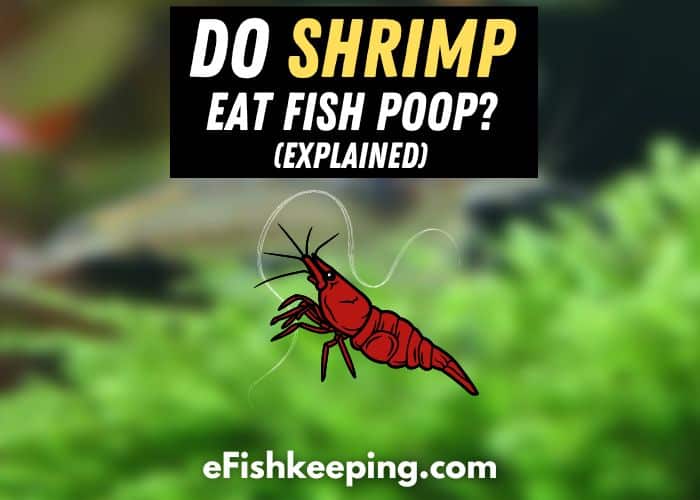
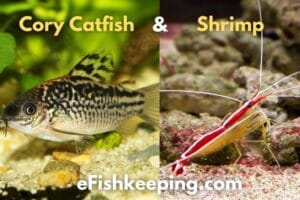

![What Do Bamboo Shrimps Eat? How? [Explained!] Close-Up-View-Of-Bamboo-Shrimp-In-Aquarium-Searching-For-Food](https://efishkeeping.com/wp-content/uploads/2022/08/Depositphotos_254633510_S-1-300x192.jpg)
